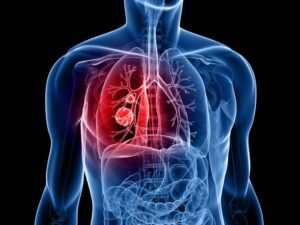Lung cancer is a pervasive and deadly disease that affects millions of people worldwide. It is a complex ailment with various factors influencing its development, progression, and treatment. Lung cancer begins when abnormal cells in the lung multiply and form a tumor. Over time, these malignant cells can invade nearby tissues and spread to other body parts, known as metastasis. To effectively combat this disease, it’s crucial to be aware of its various facets.
What are the Symptoms of Lung Cancer?
There are so many symptoms of lung cancer, some of them are-
- Persistent Cough: A chronic cough that doesn’t go away or worsens over time can be a warning sign.
- Breathing Difficulties: Shortness of breath and wheezing, especially if unrelated to a pre-existing condition, should raise concern.
- Chest Pain: Unexplained chest pain can be a symptom of lung cancer.
- Coughing Up Blood: Hemoptysis, or coughing up blood or bloody mucus, is a common sign of lung cancer.
- Hoarseness: Changes in your voice, particularly if it persists, can indicate a problem.
- Unexplained Weight Loss: Losing weight without trying can be a red flag.
- Fatigue: Ongoing fatigue that doesn’t improve with rest might be related to lung cancer.
What are the Causes of Lung Cancer?
The primary cause of lung cancer is tobacco smoke, both from smoking and exposure to secondhand smoke. Other risk factors include:
- Radon Gas: Prolonged exposure to radon, a naturally occurring gas, can increase the risk of lung cancer.
- Asbestos: Occupational exposure to asbestos fibres can lead to lung cancer.
- Environmental Factors: Pollutants, such as air pollution and certain chemicals, can contribute to the development of lung cancer.
- Genetics: A family history of lung cancer may increase an individual’s susceptibility.
How Lung Cancer is Diagnosed?
Early diagnosis is key to successful treatment. Common diagnostic methods include:
- Imaging: X-rays, CT scans, and MRIs are used to identify and locate lung tumors.
- Sputum Cytology: Examining sputum under a microscope can detect cancer cells.
- Biopsy: Tissue samples are taken and examined to confirm the presence of cancer and determine its type.
- Bronchoscopy: A thin, flexible tube is inserted into the airways to view the lungs and collect tissue samples.
What are the Types of Lung Cancer?
There are two main types of lung cancer:
- Non-Small Cell Lung Cancer (NSCLC): This is the most common type, comprising around 85% of all cases. NSCLC includes subtypes like adenocarcinoma, squamous cell carcinoma, and large cell carcinoma.
- Small Cell Lung Cancer (SCLC): SCLC is more aggressive and accounts for the remaining 15% of cases.
What are the Stages of Lung Cancer?
Lung cancer is typically categorized into stages ranging from 0 to IV, with higher stages indicating more advanced disease. Staging helps determine the extent of the cancer’s spread and guides treatment decisions.
What are the Treatment Options for Lung Cancer?
The choice of treatment depends on the type and stage of lung cancer. Common treatment options include:
- Surgery: Surgical removal of the tumor or affected lung tissue may be necessary in early-stage cases.
- Radiation Therapy: High-energy rays are used to kill cancer cells or shrink tumor.
- Chemotherapy: Powerful drugs are used to destroy cancer cells or slow their growth.
- Targeted Therapy: Medications specifically target cancer cells with certain genetic mutations.
- Immunotherapy: Boosts the body’s immune system to help fight cancer.
What Precautions Should Take After Lung Cancer Treatment?
After undergoing treatment, it’s crucial to take precautions to maintain your health and reduce the risk of recurrence:
- Follow-up Care: Attend regular follow-up appointments with your healthcare team for ongoing monitoring.
- Quit Smoking: If you smoke, quitting is the most important step to prevent lung cancer recurrence.
- Healthy Lifestyle: Maintain a balanced diet and engage in regular exercise to promote overall well-being.
- Reduce Environmental Exposures: Minimize exposure to pollutants, asbestos, and other environmental risk factors.
Conclusion
Lung cancer is a formidable adversary, but with early detection and the right treatment, it can be managed effectively. It is crucial to be aware of the symptoms, risk factors, and the importance of regular screenings. Following successful treatment, taking the necessary precautions can significantly improve your chances of leading a healthy and cancer-free life. Remember, knowledge and vigilance are your best allies in the battle against lung cancer.




